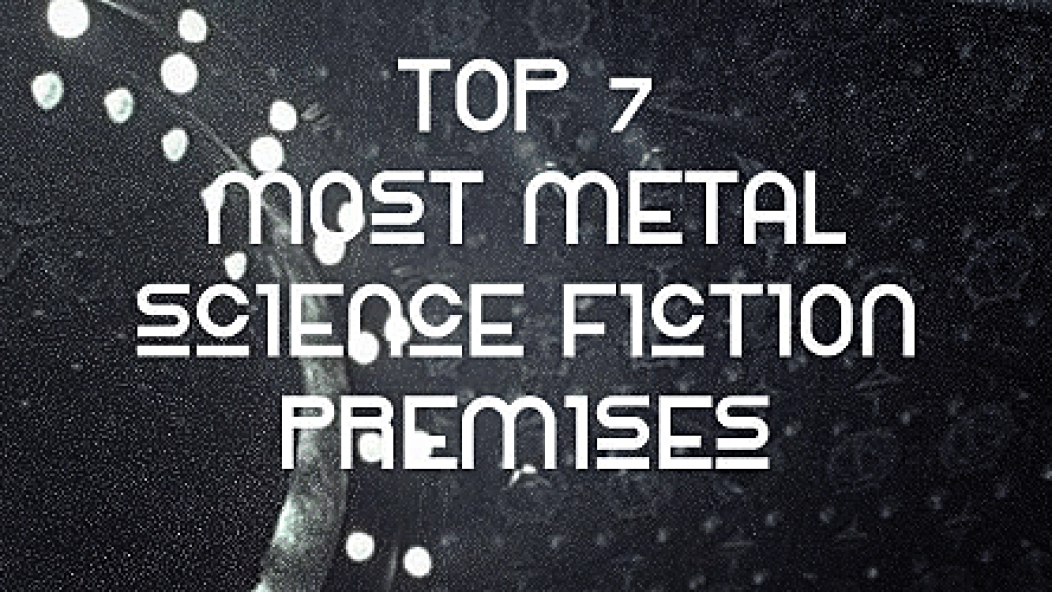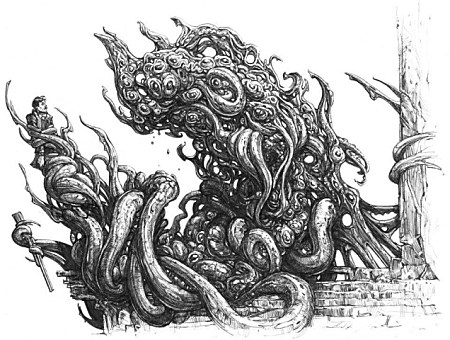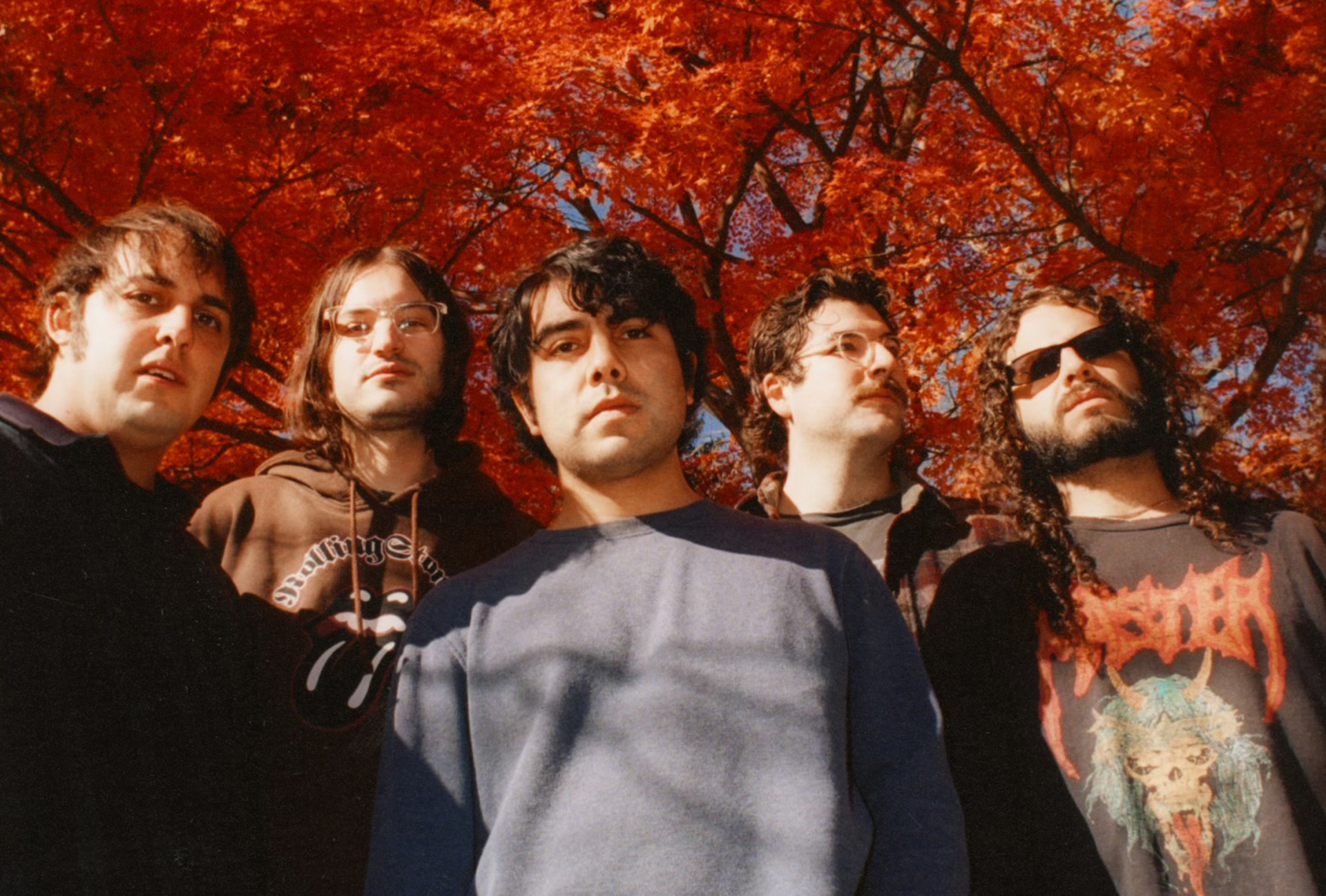
Top 7 Most Metal Science Fiction Premises
Ridley Scott’s science fiction/horror classic Alien sports one of the most effective taglines in movie history: “In space, no one can hear you scream.” I imagine that some metal bands would beg to differ, for reasons of pride. (Meshuggah’s excellent Alive DVD features a pastiche of the Alien movie poster and a modified tagline: “In space, no one can hear you unless you scream.)
Science fiction and heavy metal rub up against each other in many ways. They’re both implicitly concerned with technology—metal has machine rhythms and electric instruments. They both grapple with difficult questions about human nature. And both canons include huge swathes of art that focuses on the grossest, saddest, most desolate subjects available.
Richard Street-Jammer’s recent Dol Ammad review reminded us that neither metal nor science fiction needs to be grim and brutal, but I like ’em both best when they are. This post pays tribute to the 7 most absurdly metal science fiction premises I could think of. Why seven? Because it’s a magickal number, and I’m a contrarian.
Incidentally, Alien didn’t make the cut. I suspect that I’ve missed some other excellent candidates as well. It’s up to you to tell me what I should’ve included.
. . .
EVENT HORIZON
Traditionally, metal associates itself with supernatural villainy: Satan, hell, zombies, monsters, and so forth. Such entities rarely make it into space [unless we’re talking Leprechaun 4: In Space -Ed.], where the antagonists are typically humans, aliens (which amount to secular monsters anyhow), or the environment itself.
The 1997 film Event Horizon involves an unusual rendezvous between the chill of space and the fires of hell. The story focuses on a starship whose experimental faster-than-light engine rips wormhole-style tears in the fabric of spacetime. Upon the engine’s first use, the ship disappears for years. When it reappears in a remote corner of space, a rescue team is sent to investigate. Hilarity, of course, ensues.
Upon arriving at the ship, the team finds that the ship’s crewmembers have tortured each other to death. Further investigation reveals that the ship brought something back from the realms beyond: it turns out that hyperspace is a dimension of suffering and insanity that suspiciously resembles Hell. The residual psychic energy from this plane of shittiness drives some members of the rescue team insane. Sam Neill’s character makes some memorable modifications of his own face before attempting to drag his team back to dimension X.
Aside from the implicit metalness of all things hell-related, Event Horizon deserves a spot on this list for turning a normally harmless science fiction trope—hyperspace—into a nightmare. Event Horizon has also been sampled by a number of metal bands, including one of my favorites: Anaal Nathrakh.
. . .
http://www.youtube.com/watch?v=NOggLk5uaDM
Anaal Nathrakh – “The Technogoat”
. . .
THE HYPERION CANTOS
Like a great deal of science fiction (including most on this list), Dan Simmons’s Hyperion Cantos novel series takes place in what TV Tropes calls a “crapsack world”. As in Warhammer 40k, the human race has become a clutch of assholes as it has spread throughout the galaxy. Militarism runs rampant, a race of engineered mutants threatens human hegemony, and the AIs that operate most technology may not have our interests in mind.
These features are all common. The Hyperion Cantos deserves a spot on this list because of its most distinctive character: The Shrike.
The Shrike, a godlike biomechanical killing machine of unknown origin and intentions, is pretty much the baddest sci-fi baddie I’ve ever heard of. It is 10 feet tall, and its body is “a sculpted mass of thorns, spikes, joints, and layers of ragged razorwire.” The Shrike possesses the unsettling ability to manipulate time and space—it can appear and disappear at will, move too fast for the eye to follow, and murder its victims before they even think to defend themselves.
Ironically, the Shrike’s name comes from its tendency not to kill its foes. It prefers to consign them to the Tree of Thorns, a three-mile-high monument to agony. The Tree consists of impossibly sharp metallic spines; like its namesake bird, the Shrike impales victims on the branches of this tree. It then uses its time-control abilities to keep its skewered prey alive, and thus suffering, forever.
Most Hyperion characters fear the Shrike, but some worship it as a deity. All can agree, however, that it is the pain-killer.
. . .
Judas Priest – “Painkiller”
. . .
WARHAMMER 40,000
I’ve mentioned the tabletop RPG franchise Warhammer 40k on IO before. It’s actually kind of hard to avoid it on occasion; Warhammer 40k is better represented in metal lyrics and imagery than any other fictional world I can think of, aside from Tolkien and Lovecraft’s works.
There’s good reason for Warhammer 40k’s popularity in metal. Its tagline is “In the grim darkness of the distant future, there is only war.” The franchise follows through on its hyperbolic threat—40k overflows with awfulness. Every detail of its universe is designed to induce grimaces. Humanity has spread throughout the Milky Way, but in the process it has devolved into a chauvinist theocracy whose official policy is the eradication of all alien species. A swarm of interstellar locusts is slowly devouring the galaxy. Hyperspace, called the Warp here, is a Hellish dimension, home to supernatural evil that strives to break into reality. Various other unpleasant races and factions—immortal killer robots! fanatical renegade supersoldiers! orks!—vie for supremacy.
Some of these ideas come from elsewhere. Robert Heinlein’s Starship Troopers and the Alien series strongly influenced Warhammer 40k. Others have been repeated elsewhere, especially in Event Horizon and the Starcraft series. But 40k is so metal because of its grotesque scope. Its eternal war is to World War II as World War II is to one caveman hitting another caveman with a rock. Technology only makes things worse. Billions of people are slaughtered daily. Worlds are eaten.
And that’s where Bolt Thrower comes in.
. . .
Bolt Thrower – “World Eater”
. . .
VIDEODROME
Before director David Cronenberg started churning out Oscar bait like A History of Violence and Eastern Promises, he was one of the most distinctive and unsettling science fiction/horror directors in the history of the medium. Many of his works could’ve appeared on this list: Scanners (head-bursting psychics), The Fly (ghastly genetic hybrids), Crash (car-accident fetishists), and so on.
But for me, Videodrome easily takes the metal cake. It tells the story of a cable porn magnate named Max who uses his (very ’80s) pirate satellite dish to intercept broadcasts of a mysterious show, also called “Videodrome”. The show is essentially a series of snuff films; it depicts masked men torturing and murdering victims in a chamber that appears to be made out of flesh. (Bonus Cronenberg drinking game: take a shot whenever a character uses the word ‘flesh.’)
Max becomes obsessed with the show, at first because of its novelty but then out of physical addiction. Max discovers that “Videodrome” is not a TV show so much as a weapon. Encoded in each transmission is a signal pattern that triggers the growth of a malignant brain tumor. The tumor causes hallucinations, warps the victim’s behavior, and eventually kills him. Videodrome (the movie)’s narrative becomes more and more disjointed as Max suffers the effects of the show.
Videodrome is a fucked-up movie with strikingly gross visuals, but its titular show also offers us a neat analogue for underground metal. Both are hard to find and both deal with unsettling, taboo subjects. After the initial shock wears off, both can grow from a curiosity to an obsession. You must be careful with them, lest they start driving you a little (or a lot) crazy.
Otherwise, you might end up like Strapping Young Lad, who took the title of this song from the film.
. . .
http://www.youtube.com/watch?v=2T0_n4VsaYo
Strapping Young Lad – “All Hail the New Flesh”
. . .
AT THE MOUNTAINS OF MADNESS
When I initially pitched the idea for this series to our august editor, he resisted my desire to include At the Mountains of Madness. H.P. Lovecraft’s seminal novella is not science fiction, he said, but rather “weird fiction”—a separate genre of speculative fiction. And he’s right; At the Mountains of Madness is not science fiction, strictly speaking. But I believe that it deserve a place in this series firmly enough that I eventually convinced him.
For starters, Lovecraft’s metalness is utterly unimpeachable. Tolkien’s work may have inspired more band names, but from “The Call of Ktulu” to Trey Azagthoth, there’s no author whose hand rests heavier on metal’s tiller. Lovecraft deserves a mention in any discussion of metal fiction in general.
And in my view, this particular work is science-y enough to fit the bill. At the Mountains of Madness follows a pair of early 20th-century scientists who stumble across the remnants of an alien civilization in Antarctica. The civilization is not as dead as it seems at first, and the explorers are driven to the brink of madness by what they find there.
It’s important to note that while the Old Ones (the alien race in question) and their various rivals possess seemingly impossible shapes and powers, these features aren’t explicitly magical. The aliens are just so much more advanced than humanity that their bodies and technology register as magic, Clarke’s Law-style. Lovecraft is implicitly criticizing the inability of his day’s science to adequately explain the world.
The idea at the heart this story, and at the heart of much of Lovecraft’s work, is this: There are bigger, stronger animals out there than humans. These animals do not mean us well. And we’re too dumb to even begin to comprehend them, much less to fight back against them.
Metallica are the most famous metal proponents of Lovecraft’s work. “The Thing That Should Not Be” isn’t explicitly about At the Mountains of Madness, but its title captures the core idea of the story anyhow.
. . .
http://www.youtube.com/watch?v=6XyEZEXjq6U
Metallica – “The Thing That Should Not Be”
. . .
RIDDLEY WALKER
A lot of science fiction takes place after a major nuclear war. Such settings are usually bleak, but the bleakness varies in degree.
At the lighter end of the spectrum, you have stories like Walter Miller’s A Canticle for Leibowitz, in which human civilization eventually rebuilds its entire infrastructure. In the center are yarns like Mad Max and Robert McGammon’s (mostly fantasty) Swan Song, in which human civilization sustains massive damage but limps onward. At the dark end lies On the Beach, which describes the gradual extinction of humanity.
And then there’s Riddley Walker, which hypothesizes a fate worse than death for mankind. Russell Hoban’s 1980 novel is set thousands of years after a cataclysmic nuclear exchange. Humanity survives this war, but the damage to Earth’s biosphere prevents civilization from recovering. Instead, the descendents of modernity live in a state of perpetual barbarism: literacy is virtually unheard of, tribal warfare is rampant, and death at the hands of starvation, exposure, and even the predation of wild animals constitute daily worries.
Riddley Walker’s most tortuous moments come when its characters discuss their deeply ignorant version of history. The book reveals that humanity not only endures generation after generation of hell, but it has lost all memory of how it came to suffer such a fate. High technology lays us low, permanently. Riddley Walker is one of the most upsetting works on this list because it is the most plausible.
. . .
http://www.youtube.com/watch?v=qv3lWeZvQWE
Coffins – “Mortification to Ruin”
. . .
“I HAVE NO MOUTH, AND I MUST SCREAM”
For me, this is it. Harlan Ellison’s short story has the blackest, grimmest, most painfully metal science fiction premise I’ve ever encountered. Written in a single night, it roils a mess of SF’s bleakest concerns—nuclear annihilation, out-of-control weapons technology, malevolent artificial intelligence, and the dark side of immortality—into a morass of purest misery.
“I Have No Mouth, and I Must Scream” takes place in the aftermath of a nuclear holocaust. As in Terminator, a military supercomputer called AM becomes sentient during the course of this war and uses its weapons to exterminate humanity. But no scrappy resistance remains. Only five humans survive the holocaust, and not by chance.
AM becomes a secular god, able to manipulate matter at will. It is a cruel god. Filled with spite for its creators, the machine uses its power to impose an endless living hell on the last remnant of mankind. AM visits such a cavalcade of physical torture, sexual defilement, and psychological violation on its playthings that Harlan Ellison himself now kind of creeps me out. The humans’ only hope of salvation is suicide, which AM mockingly denies them at every turn. The story begins in their 109th year of agony.
I have plenty of practice describing things in lurid detail, but “I Have No Mouth, and I Must Scream” is so grotesque that it defies my efforts. Read it here if plumbing the depths of horribleness is your idea of fun. It’s short, but it will stay with you.
Here’s a reprint of AM’s speech:
HATE.
LET ME TELL YOU HOW MUCH I’VE COME TO HATE YOU SINCE I BEGAN TO LIVE. THERE ARE 387.44 MILLION MILES OF PRINTED CIRCUITS IN WAFER-THIN LAYERS THAT FILL MY COMPLEX. IF THE WORD ‘HATE’ WAS ENGRAVED ON EACH NANOANGSTROM OF THOSE MILLIONS OF MILES IT WOULD NOT EQUAL ONE ONE-BILLIONTH OF THE HATE I FEEL FOR HUMANS AT THIS MICRO-INSTANT. FOR YOU.
HATE. HATE.
. . .
Meshuggah – “Future Breed Machine”
. . .














